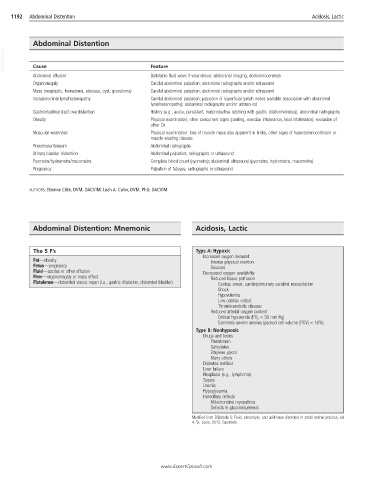Page 2408 - Cote clinical veterinary advisor dogs and cats 4th
P. 2408
1192 Abdominal Distention Acidosis, Lactic
Abdominal Distention
VetBooks.ir Cause Feature
Abdominal effusion Ballotable fluid wave if voluminous; abdominal imaging; abdominocentesis
Organomegaly Careful abdominal palpation; abdominal radiographs and/or ultrasound
Mass (neoplastic, hematoma, abscess, cyst, granuloma) Careful abdominal palpation; abdominal radiographs and/or ultrasound
Intraabdominal lymphadenopathy Careful abdominal palpation; palpation of superficial lymph nodes (variable association with abdominal
lymphadenopathy); abdominal radiographs and/or ultrasound
Gastrointestinal tract overdistention History (e.g., acute, persistent, nonproductive retching with gastric dilation/volvulus), abdominal radiographs
Obesity Physical examination; other concurrent signs (panting, exercise intolerance, heat intolerance); exclusion of
other Dx
Muscular weakness Physical examination: loss of muscle mass also apparent in limbs, other signs of hyperadrenocorticism or
muscle-wasting disease
Pneumoperitoneum Abdominal radiographs
Urinary bladder distention Abdominal palpation; radiographs or ultrasound
Pyometra/hydrometra/mucometra Complete blood count (pyometra); abdominal ultrasound (pyometra, hydrometra, mucometra)
Pregnancy Palpation of fetuses; radiographs or ultrasound
AUTHORS: Etienne Côté, DVM, DACVIM; Leah A. Cohn, DVM, PhD, DACVIM
Abdominal Distention: Mnemonic Acidosis, Lactic
The 5 F’s Type A: Hypoxic
Increased oxygen demand
Fat—obesity Intense physical exertion
Fetus—pregnancy Seizures
Fluid—ascites or other effusion Decreased oxygen availability
Firm—organomegaly or mass effect Reduced tissue perfusion
Flatulence—distended viscus organ (i.e., gastric dilatation, distended bladder) Cardiac arrest, cardiopulmonary cerebral resuscitation
Shock
Hypovolemia
Low cardiac output
Thromboembolic disease
Reduced arterial oxygen content
Critical hypoxemia (PO 2 < 30 mm Hg)
Extremely severe anemia (packed cell volume [PCV] < 10%)
Type B: Nonhypoxic
Drugs and toxins
Phenformin
Salicylates
Ethylene glycol
Many others
Diabetes mellitus
Liver failure
Neoplasia (e.g., lymphoma)
Sepsis
Uremia
Hypoglycemia
Hereditary defects
Mitochondrial myopathies
Defects in gluconeogenesis
Modified from DiBartola S: Fluid, electrolyte, and acid-base disorders in small animal practice, ed
4, St. Louis, 2012, Saunders.
www.ExpertConsult.com

